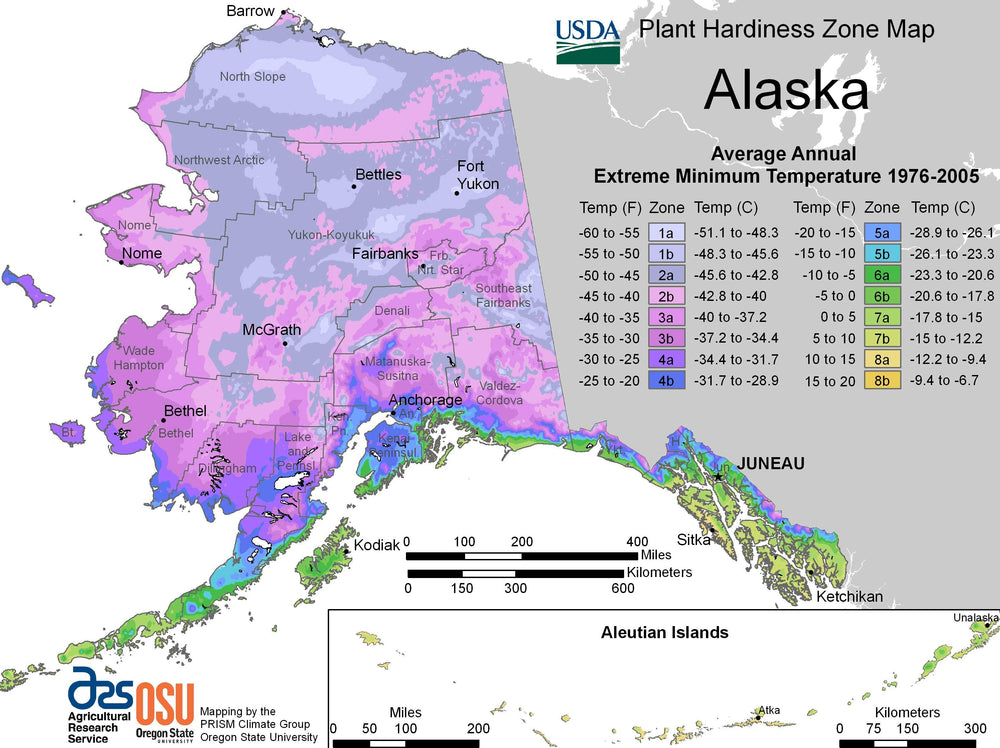Alaskan Hardiness Zones
Characteristics of Alaska Planting Region

Alaskan Lakeside View
The Alaskan growing region is characterized to be one of unique climate and geography. This can be viewed as both a challenge or an opportunity for agriculture. The region has the shortest growing season in the US. It usually lasts from May to September, so farmers have a very limited time to plant, grow and reap their crops.
During the summer months Alaska experiences long hours of daylight. For certain crops, this can be very beneficial, but for some others that are short-day plants, like strawberries, it’s not ideal.
The cool temperatures of the region are ideal for certain crops like berries and leafy greens. These cooler temperatures go hand in hand with frost, a major problem for farmers.
The Alaskan landscape is often terrorized by weather extremes like:
- Temperature Extremes- as low as -70°F (-56.6°C).
- Heavy Snowfall- annual average of 20ft
- Strong Winds- wind gusts of up to 70 mph (125 kph).
Challenges of Growing in Alaska

-
Short Growing Season
Alaska’s growing season is very short, the shortest in the country. It usually only lasts from mid-May to mid-September. This issue is a big problem for farmers and gardeners as it makes it difficult to grow crops that require a longer growing season. -
Extreme Weather Conditions
Alaska experiences multiple extreme weather conditions that affect growers. These weather extremes include very strong winds, freezing temperatures, and heavy rainfall. These conditions can damage crops and make it difficult to maintain them. -
Lack of Sunlight
Majority of the crops that you’ll want to grow in Alaska need more sunlight than the region gets in the winter months. This will be incredibly challenging for farmers if they don’t equip themselves with greenhouses and grow lights.
The Benefits of Using a Greenhouse in Alaska
The Alaskan region has many hurdles relating to the weather and its geographical location making it extremely difficult for farmers and gardeners to enjoy an ideal, prolonged growing season. Luckily, with the use of a greenhouse, growers can create a controlled growing environment. Greenhouses trap heat and allow for artificial lighting setups to be installed, allowing for the growing season to be extended.
-
Extended Growing Season
Without the use of a greenhouse, the growing season in Alaska is notoriously short. Typically it runs from May to September, which limits the time farmers and gardeners have to grow and harvest crops.
With a greenhouse, Alaskan growers can extend their growing season way beyond the short summer months. You can use your greenhouse to create a warm and protected environment in which plants can thrive.
-
Protection from Extreme Weather Conditions
Greenhouses can protect your crops from the many harsh weather conditions in Alaska. These could be one of or a combination of strong winds, heavy rainfall, and snowstorms. These structures will provide a protected space for plants to grow by sheltering them from the elements.
- Versatile Crop Production
The unforgiving Alaskan climate will limit what you can grow, but greenhouses change everything. Without greenhouses, you’ll only be able to grow crops like:
- Root Vegetables
- Brassicas
- Berries
- Salad Greens
- Herbs
Greenhouses will allow you to produce a much wider range of crops including vegetables, herbs, fruits, and flowers, that wouldn’t thrive in the Alaskan climate. Your growing catalog can now consist of:
- Tomatoes
- Peppers
- Cucumbers
- Melons
- Greens and Herbs
- Flowers
- Root Vegetables
- Brassicas
- Berries
- Salad Greens
- Herbs

Greenhouse Garden
Why Planta Greenhouses?
- Wind resistant up to 65 mph (learn more about how our greenhouses hold up in high-altitude climates).
- Withstands a snow load of up to 98 psf (480kg/square meter).
- Made with a heavy-duty galvanized steel frame.
- Polycarbonate panels provide 100% protection against UV rays.
- The Sungrow greenhouse is bell-shaped - allows the wind, snow, and hail to slide off the sides.
- Extendable (Sungrow, Sigma and Farmer models can be extended beyond 100ft)
- Made in Europe and are exclusively imported
- Maintenance-free

